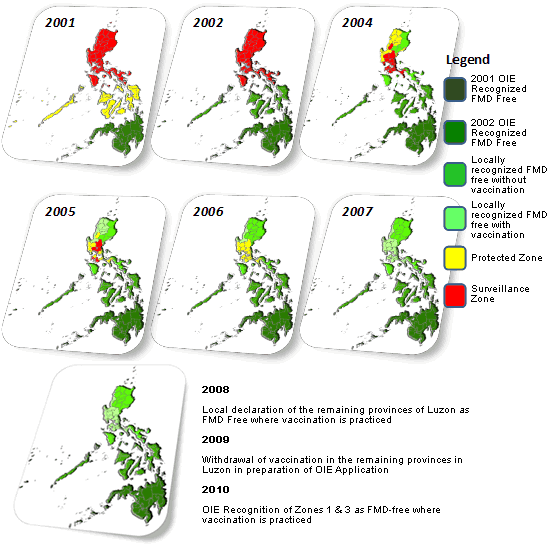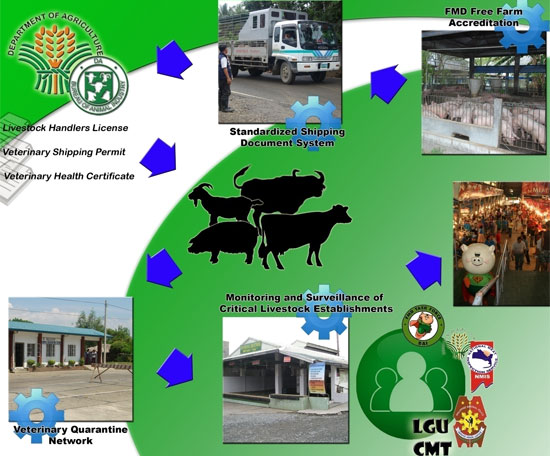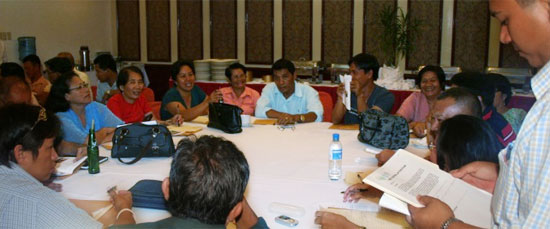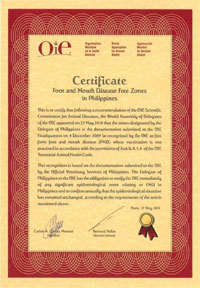In 1996, the NFMDTF drafted a national plan to address the 1995 FMD epidemic wherein 98,000 animals were reported to have been affected. The plan to eradicate FMD involved four (4) component strategies:
Disease Monitoring and Surveillance is divided into an active and passive component:

a. Active – serological surveys, clinical monitoring of farms, slaughterhouses, stockyards and weighing stations for signs indicative of FMD including monitoring of susceptible animals in transit inspected through the different veterinary quarantine facilities.
b. Passive – monthly negative monitoring reports.
Surveillance was strengthened to immediately detect outbreaks and also to identify high risk areas. Epithelial samples were collected from affected animals to monitor circulating serotypes. Intensive surveillance revealed that the outbreaks after 1995 were of the pig – lenient serotype although cattle and buffaloes were also present in the affected areas.
Public Awareness complemented the technical initiatives of the FMD eradication campaign by using science based communication techniques to enjoin various stakeholder groups. It includes educating and heightening the level of awareness of the FMD campaign, particularly in consumer advocacy initiatives on disease-free meat.
Animal Movement Management pertains to the regulation of movement of susceptible animals, which has been critical to the eradication strategy, specifically with the progressive zoning approach. The NFMDTF applied the progressive zoning approach by classifying different regions based on their FMD status. Eradication of the disease started from Northern and Southern Luzon provinces slowly moving towards the Central part of Luzon since movement of livestock gravitates that way.

Critical pathway analysis led to the identification of livestock markets, holding yards and abattoirs as high risk areas for FMD virus maintenance. The Compliance Monitoring Team was created to monitor compliance to existing guidelines on shipments and slaughter of FMD susceptible animals with focused interventions on the identified nodes of the Critical Pathway that led to the elimination of clinical cases and achieving a no-outbreak scenario from 28 December 2005 to date. The NFMDTF implemented selective stamping out and massive disinfection in these areas to eliminate the virus. These two measures were the most critical intervention measures during the last stage of FMD eradication in the country.

Vaccination played an integral role in the attainment of protective titer for FMD susceptible animals in an area. Only vaccines that satisfy the requirements of the OIE Manual were used in the country. O1 Manisa vaccines produced from Europe were first used to combat the pig – adapted Cathay topotype. This was later replaced with a pig – adapted local isolate O Philippines 97. Strategic mass vaccination was applied in identified high risk areas such as farms, nearby livestock markets, holding yards and abattoirs. Due to the absence of FMD reported outbreaks for more than 3 years, a complete withdrawal of FMD vaccination has been formalized by virtue of AO No. 12 series of 2009.
The timeline for the eradication of FMD in the Philippines involved three phases:
1. Control Phase (1996-2000) – aimed at reducing the incidence in high-risk areas (high livestock density/ high livestock activity) and eliminating cases in remaining low-risk areas.
2. Consolidation Phase (2000-2004) – focused on the elimination of cases in the high-risk areas and intensification of disease monitoring and surveillance activities.
3. Eradication Phase (2004-2009) – geared at significant reduction of outbreaks and implementation of the progressive zoning approach in Luzon to achieve disease eradication and to serologically map Luzon to locate the last foci of infection.

Early Warning System and Emergency Preparedness
The NFMDTF adapted the Emergency Prevention System (EMPRES) of the United Nations Food and Agriculture Organization (UN-FAO) in developing and assessing contingency and preparedness plans. A local version of EMPRES dubbed Emergency Preparedness which is a collection of strategies aimed at controlling FMD outbreaks in the shortest time possible and preventing FMD was conceptualized in 1999 by the NFMDTF.
The principal objective of EMPRES is to ensure that necessary plans in case of animal disease emergencies are in place, and that concerned officers and personnel are kept abreast with the technologies and practices in place, through training and preparedness workshops, including simulation exercises. The goal is to complement early detection programs in place with competitive personnel who can efficiently implement a quick response, in case of emergencies.
The local version of the EMPRES workshop was conducted to guide the Local Government Units in the Luzon, Visayas and Mindanao in setting up contingency plans. This involved an effective early warning system and early reaction capability that would equip the field personnel in reacting swiftly to animal disease emergencies such as FMD.
To keep up the stakeholders’ level of awareness on maintaining the gains achieved a field manual entitled “Animal Health Personnel Field Manual” was designed to help field people such as livestock inspectors (LI) and agriculture technicians (AT) in their routine livestock monitoring tasks. This contained topics on animal disease recognition, animal disease emergency preparedness, and risk and crisis communications with the purpose of providing the basic yet useful information to the local program implementers. Concomitantly, disease reporting and monitoring report forms have been standardized by the Philippine Animal Health Information System (Phil-AHIS) team to allow organized consolidation of field reports from the municipal to the national level. Series of lectures/seminars were held to assist the LIs and ATs as stakeholders with the use of the new field manual and the standardized forms.
Moreover, capacity building activities were also conducted for the veterinary quarantine personnel manning the various strategically situated quarantine facilities in the country. Re-orientation seminars were imperative to continuously update the veterinary quarantine guards of the different guidelines and/or protocols on animal movement management relevant to the conduct of their function as quarantine authorities.
FMD Tabletop Simulation Exercise
In relation to contingency planning, the NFMDTF developed a Comprehensive Scenario-Induced Simulation Exercise (CSI-Simex) built as an integral part of the program. This was initially conducted in the internationally recognized FMD Free Areas of Region 12 in Mindanao and Iloilo City in Visayas in 2007.

The main goal of the simulation was to assess the soundness and efficiency of the responses of officers when given an outbreak scenario. While only a table-top simulation, the said exercise revolved around a scenario induced framework where reactions are measured based on set SOP and fitted against time.
Currently, the task force has the preparedness and contingency planning as a central component of existing activities in the regions.
Summary and conclusion
The government of the Philippines through the Department of Agriculture-Bureau of Animal Industry (DA-BAI) has finally achieved its goal of eradicating FMD an although still waiting for OIE recognition for Zone 2 of Luzon, it would be the second disease eradicated in the country after Rinderpest in 1972.
 The FMD eradication campaign in the country was actually difficult and would have been more difficult if not for the foreign funding support from AusAID through FAO, which significantly augmented the government resources the BAI used in the entire eradication program of 15 years. It should be noted that the success of the program highly depended on the structure of the national plan to eradicate the disease. The National FMD Task Force has responsibly executed the program components through a network which it established as counterpart program
The FMD eradication campaign in the country was actually difficult and would have been more difficult if not for the foreign funding support from AusAID through FAO, which significantly augmented the government resources the BAI used in the entire eradication program of 15 years. It should be noted that the success of the program highly depended on the structure of the national plan to eradicate the disease. The National FMD Task Force has responsibly executed the program components through a network which it established as counterpart program
implementers from regional to municipal levels as well as different stakeholders from farmers to consumers, policy makers, various livestock organizations, and veterinary professional organizations, other government agencies, etc. that all contributed to the success of the program.
Constant coordination with the different stakeholders addressing each of their issues which were identified using the critical pathway assertively helped in the implementation of eradication activities particularly focusing on animal movement and sero-surveillance. The creation of CMT was considered a radical measure as it mandated the team to confiscate and condemn all animals found infected with FMD in any livestock facilities without compensatingthe animal owners. Through their rigorous monitoring of livestock pooling places, the true picture of FMD outbreak level was established providing the much needed information to guide policy makers in its task, and consequently sending a clear message to anyone who would disregard the government’s course of action on FMD eradication campaign.
With the pending approval of OIE to Zone 2 application, a day is always a challenge for the NFMDTF and its counterpart program implementers to maintain FMD-freedom in every part of the country, and the same should be deemed by every stakeholder. The BAI ensures that FMD eradication activities are still sustained through establishment of sustainable programs such as Phil-AHIS, routine conduct of EMPRES workshops and simulation exercises, strengthening of quarantine services, and the regular coordination with all stakeholder organizations. Moreover, as the livestock industry is currently experiencing the effect of emerging and re-emerging diseases, an act to protect the livestock industry must be very well considered. Through all these measures, recurrence not only of FMD but also of other diseases as well would be pre-empted, which could bring forth the Philippines to the global arena.
NOTE: In June, 2011, the Philippines obtained the OIE certificate as FMD Free country without vaccination.



